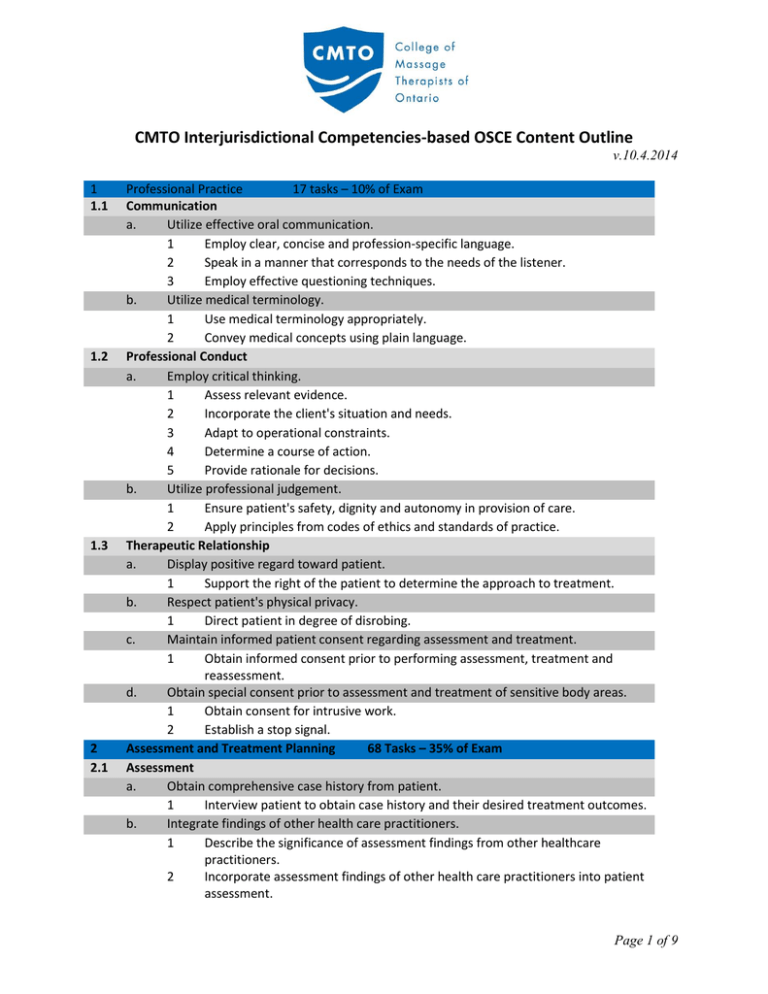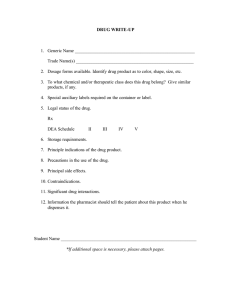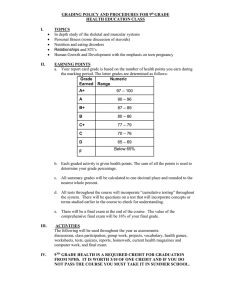CMTO Interjurisdictional Competencies
advertisement

CMTO Interjurisdictional Competencies-based OSCE Content Outline v.10.4.2014 1 1.1 1.2 1.3 2 2.1 Professional Practice 17 tasks – 10% of Exam Communication a. Utilize effective oral communication. 1 Employ clear, concise and profession-specific language. 2 Speak in a manner that corresponds to the needs of the listener. 3 Employ effective questioning techniques. b. Utilize medical terminology. 1 Use medical terminology appropriately. 2 Convey medical concepts using plain language. Professional Conduct a. Employ critical thinking. 1 Assess relevant evidence. 2 Incorporate the client's situation and needs. 3 Adapt to operational constraints. 4 Determine a course of action. 5 Provide rationale for decisions. b. Utilize professional judgement. 1 Ensure patient's safety, dignity and autonomy in provision of care. 2 Apply principles from codes of ethics and standards of practice. Therapeutic Relationship a. Display positive regard toward patient. 1 Support the right of the patient to determine the approach to treatment. b. Respect patient's physical privacy. 1 Direct patient in degree of disrobing. c. Maintain informed patient consent regarding assessment and treatment. 1 Obtain informed consent prior to performing assessment, treatment and reassessment. d. Obtain special consent prior to assessment and treatment of sensitive body areas. 1 Obtain consent for intrusive work. 2 Establish a stop signal. Assessment and Treatment Planning 68 Tasks – 35% of Exam Assessment a. Obtain comprehensive case history from patient. 1 Interview patient to obtain case history and their desired treatment outcomes. b. Integrate findings of other health care practitioners. 1 Describe the significance of assessment findings from other healthcare practitioners. 2 Incorporate assessment findings of other health care practitioners into patient assessment. Page 1 of 9 c. d. e. f. g. h. Select and perform assessments incorporating knowledge of patient history, contraindications, precautions and evidence. 1 Select appropriate assessment procedures. Perform postural assessment. 1 Identify the indications, contraindications and precautions for performing postural assessment. 2 Explain assessment to the patient. 3 Describe the process for performing a postural assessment. 4 Demonstrate postural assessment based upon patient history and presentation. 5 Differentiate between normal and abnormal findings. 6 Describe the relationship between abnormal findings and clinical manifestations. Perform palpatory assessment. 1 Identify the indications, contraindications and precautions for performing palpatory assessment. 2 Explain assessment to the patient. 3 Describe the process for performing a palpatory assessment. 4 Demonstrate palpatory assessment based upon patient history and presentation. 5 Differentiate between normal and abnormal findings. 6 Describe the relationship between abnormal findings and clinical manifestations. Perform range of motion assessment. 1 Identify the indications, contraindications and precautions for performing range of motion assessment. 2 Explain assessment to the patient. 3 Describe the process for performing a range of motion assessment. 4 Demonstrate range of motion assessment based upon patient history and presentation. 5 Differentiate between normal and abnormal findings. 6 Describe the relationship between abnormal findings and clinical manifestations. Perform muscle length assessment. 1 Identify the indications, contraindications and precautions for performing muscle length assessment. 2 Explain assessment to the patient. 3 Describe the process for performing a muscle length assessment. 4 Demonstrate muscle length assessment based upon patient history and presentation. 5 Differentiate between normal and abnormal findings. 6 Describe the relationship between abnormal findings and clinical manifestations. Perform muscle strength assessment. Page 2 of 9 1 i. j. k. l. m. Identify the indications, contraindications and precautions for performing muscle strength assessment. 2 Explain assessment to the patient. 3 Describe the process for performing a muscle strength assessment. 4 Demonstrate muscle strength assessment based upon patient history and presentation. 5 Differentiate between normal and abnormal findings. 6 Describe the relationship between abnormal findings and clinical manifestations. Perform joint play assessment. 1 Identify the indications, contraindications and precautions for performing joint play assessment. 2 Explain assessment to the patient. 3 Describe the process for performing a joint play assessment. 4 Differentiate between normal and abnormal findings. 5 Describe the relationship between abnormal findings and clinical manifestations. Perform neurological assessment. 1 Identify the indications, contraindications and precautions for performing neurological assessment. 2 Explain assessment to the patient. 3 Describe the process for performing a neurological assessment. 4 Demonstrate neurological assessment based upon patient history and presentation. 5 Differentiate between normal and abnormal findings. 6 Describe the relationship between abnormal findings and clinical manifestations. Perform vital sign assessment. 1 Identify the indications, contraindications and precautions for performing vital signs assessment. 2 Explain assessment to the patient. 3 Describe the process for performing a vital signs assessment. 4 Demonstrate vital signs assessment based upon patient history and presentation. 5 Differentiate between normal and abnormal findings. 6 Describe the relationship between abnormal findings and clinical manifestations. Perform appropriate special tests (specific selected assessments). 1 Identify the indications, contraindications and precautions for selecting a specific assessment. 2 Explain the purpose of the selected assessment. 3 Explain how the selected assessment affects the involved tissues. 4 Explain assessment to patient. 5 Demonstrate the selected assessment. Interpret findings and formulate clinical impression / differential diagnosis. Page 3 of 9 2.2 3 3.1 1 Analyze findings. 2 Formulate a clinical impression / differential diagnosis. 3 Communicate findings to patient. n. Refer patient to other health care professionals when appropriate. 1 Identify conditions that may benefit from referral. 2 Communicate referral recommendations to patient. Treatment Planning a. Formulate individualized treatment plan based upon assessment findings. 1 Describe the relationship between treatment planning and outcomes. 2 Incorporate assessment findings into treatment plan. 3 Adapt treatment plan according to findings and patient's desired outcomes. b. Select treatment modalities and techniques based upon indications, contraindications, precautions and patient stage of life. 1 Select techniques that are appropriate to the patient's conditions and desired outcomes. 2 Formulate a treatment that addresses the patient's conditions and desired outcomes. c. Reassess patient, and adapt treatment plan as needed. 1 Summarize reassessment findings, treatment outcomes and patient condition. 2 Modify treatment plan according to new findings. Treatment and Patient Self-Care 101 Tasks 55% of Exam Treatment Principles a. Treat in a manner that reflects the principles of massage 1 Apply the principles of massage therapy to treatment. b. Apply standard hygiene and infection control precautions. 1 Apply standard precautions for infection control. c. Apply draping as relevant. 1 Drape patient appropriately for treatment. d. Position patient for selected therapeutic techniques. 1 Select appropriate positioning. 2 Direct and position patient. 3 Modify position according to patient response. e. Apply modalities and techniques in a manner consistent with patient presentation. 1 Demonstrate knowledge of anatomy, physiology, & pathology related to conditions listed in the Appendix. 2 Apply treatment modalities and techniques incorporating knowledge of commonly occurring conditions, as listed in the Appendix. 3 Treat in a manner appropriate to patient presentation. f. Apply treatment modalities and techniques incorporating knowledge of indications, contraindications, precautions and patient stage of life. 1 Determine indications, contraindications and precautions for treatment based upon patient stage of life. 2 Employ modalities and techniques for safe and effective treatment based upon patient stage of life. Page 4 of 9 g. Advise and instruct patient on self care. 1 Describe the value of patient self care. 2 Select self care based upon patient presentation. 3 Instruct patient in self care. 3.2 Modalities and Techniques 3.2a Massage Skills 1 Perform effleurage techniques. 1 Demonstrate effleurage techniques. 2 Incorporate effleurage into a comprehensive treatment process. 3 Modify effleurage based on patient history, presentation and response. 2 Perform stroking techniques. 1 Demonstrate stroking techniques. 2 Incorporate stroking into a comprehensive treatment process. 3 Modify stroking based on patient history, presentation and response. 3 Perform petrissage techniques. 1 Demonstrate petrissage techniques. 2 Incorporate petrissage into a comprehensive treatment process. 3 Modify petrissage based on patient history, presentation and response. 4 Perform skin rolling techniques. 1 Demonstrate skin rolling techniques. 2 Incorporate skin rolling into a comprehensive treatment process. 3 Modify skin rolling based on patient history, presentation and response. 5 Perform vibration techniques. 1 Demonstrate vibration techniques. 2 Incorporate vibration into a comprehensive treatment process. 3 Modify vibration based on patient history, presentation and response. 6 Perform percussive techniques. 1 Demonstrate percussive techniques. 2 Incorporate percussive techniques into a comprehensive treatment process. 3 Modify percussive techniques based on patient history, presentation and response. 7 Perform rocking and shaking techniques. 1 Demonstrate rocking and shaking techniques. 2 Incorporate rocking and shaking into a comprehensive treatment process. 3 Modify rocking and shaking based on patient history, presentation and response. 8 Perform friction techniques. 1 Demonstrate friction techniques. 2 Incorporate friction into a comprehensive treatment process. 3 Modify friction based on patient history, presentation and response. 9 Perform muscle stripping techniques. 1 Demonstrate muscle stripping techniques. 2 Incorporate muscle stripping into a comprehensive treatment process. Page 5 of 9 3.2.b 3.2.c 3 Modify muscle stripping based on patient history, presentation and response. 10 Perform muscle approximation techniques. (musculo-skel conditions) 1 Demonstrate muscle approximation techniques. 2 Incorporate muscle approximation into a comprehensive treatment process. 3 Modify muscle approximation based on patient history, presentation and response. 11 Perform origin / insertion techniques. 1 Demonstrate origin / insertion techniques. 2 Incorporate origin / insertion into a comprehensive treatment process. 3 Modify origin / insertion based on patient history, presentation and response. 12 Perform Golgi tendon organ techniques. 1 Demonstrate Golgi tendon organ techniques. 2 Incorporate Golgi tendon organ techniques into a comprehensive treatment process. 3 Modify Golgi tendon organ techniques based on patient history, presentation and response. 13 Perform lymphatic drainage techniques. 1 Demonstrate the different types of lymphatic drainage techniques. 2 Incorporate lymphatic drainage into a comprehensive treatment process. 3 Modify lymphatic drainage based on patient history, presentation and response. Myofascial Techniques 1 Perform trigger point release techniques. 1 Demonstrate the different types of trigger point release techniques. 2 Incorporate trigger point release techniques into a comprehensive treatment process. 3 Modify trigger point release techniques based on patient history, presentation and response. 2 Perform strain induction techniques (fascial). 1 Demonstrate the different types of strain induction techniques. 2 Incorporate strain induction techniques into a comprehensive treatment process. 3 Modify strain induction techniques based on patient history, presentation and response. Therapeutic Exercise 1 Choose equipment and / or environment for selected therapeutic exercise technique. 1 Ensure equipment utilized is appropriate and safe for patient presentation. 2 Perform contract / relax techniques. 1 Demonstrate contract / relax techniques. 2 Incorporate contract / relax techniques into a comprehensive treatment process. 3 Modify contract / relax techniques based on patient history, presentation and response. 3 Perform contract / relax / contract techniques. 1 Demonstrate contract / relax / contract techniques. Page 6 of 9 2 3.2.d Incorporate contract / relax / contract techniques into a comprehensive treatment process. 3 Modify contract / relax / contract techniques based on patient history, presentation and response. 4 Perform agonist contraction techniques. 1 Demonstrate agonist contraction techniques. 2 Incorporate agonist contraction techniques into a comprehensive treatment process. 3 Modify agonist contraction techniques based on patient history, presentation and response. 5 Perform stretch techniques. 1 Demonstrate stretch techniques. 2 Incorporate stretch techniques into a comprehensive treatment process. 3 Modify stretch techniques based on patient history, presentation and response. 6 Perform active assisted range of motion techniques. 1 Demonstrate active assisted range of motion techniques. 2 Incorporate active assisted range of motion techniques into a comprehensive treatment process. 3 Modify active assisted range of motion techniques based on patient history, presentation and response. 7 Perform passive range of motion techniques. 1 Demonstrate passive range of motion techniques. 2 Incorporate passive range of motion techniques into a comprehensive treatment process. 3 Modify passive range of motion techniques based on patient history, presentation and response. 8 Direct patient in active range of motion techniques. 1 Demonstrate active range of motion techniques. 2 Incorporate active range of motion techniques into a comprehensive treatment process. 3 Modify active range of motion techniques based on patient history, presentation and response. 9 Perform isometric and isotonic resistance exercise techniques. 1 Demonstrate isometric and isotonic resistance exercise techniques. 2 Incorporate isometric and isotonic resistance exercise techniques into a comprehensive treatment process. 3 Modify isometric and isotonic resistance exercise techniques based on patient history, presentation and response. 10 Direct patient in balance exercises. 1 Direct balance exercise techniques. 2 Incorporate balance exercise techniques into a comprehensive treatment process. 3 Modify balance exercise techniques based on patient history, presentation and response. Joint Mobilization Page 7 of 9 1 3.2.e Perform traction and distraction techniques. 1 Explain the purposes, effects and outcomes of traction and distraction techniques. 2 Demonstrate traction and distraction techniques. 3 Incorporate traction and distraction techniques into a comprehensive treatment process. 4 Modify traction and distraction techniques based on patient history, presentation and response. 2 Perform oscillation techniques. 1 Explain the purposes, effects and outcomes of oscillation techniques. 2 Demonstrate oscillation techniques. 3 Incorporate graded oscillation techniques into a comprehensive treatment process. 4 Modify graded oscillation techniques based on patient history, presentation and response. 3 Perform sustained glide techniques. 1 Explain the purposes, effects and outcomes of sustained glide techniques. 2 Demonstrate sustained glide techniques. 3 Incorporate graded sustained glide techniques into a comprehensive treatment process. 4 Modify graded sustained glide techniques based on patient history, presentation and response. Thermal Therapy 1 Perform techniques utilizing therapeutic heating. 1 Incorporate techniques utilizing therapeutic heating into a comprehensive treatment process. 2 Perform cold pack treatments. 1 Incorporate cold pack treatments into a comprehensive treatment process. Appendix A A1 A2 Common clinical conditions that present as variables of a. Pain b. Mood c. Anxiety d. Sleep e. Cognition Conditions with multi-factorial considerations a. Inflammation b. Infection c. Scarring d. Swelling e. Congestion f. Movement restriction Page 8 of 9 g. A3 A4 A5 A6 A7 Malignancy Stages of life a. Pregnancy b. Infancy and childhood c. Adolescence d. Adulthood e. Senior years f. End of life Neurological conditions a. Of the central nervous system b. Of the peripheral nervous system c. General neurological conditions Orthopedic conditions a. Of the bone and periosteum b. Of the muscles and tendons c. Of the fascia d. Of the skin and connective tissue e. Of the synovial joints, cartilage, ligaments and bursa f. Systemic myofascial and orthopedic conditions Post-surgical conditions involving a. Orthopedic interventions b. Artificial openings c. Implants Systemic conditions of the a. Cardiovascular system b. Digestive system c. Endocrine system d. Gastrointestinal system e. Immune system f. Integumentary system g. Lymphatic system h. Reproductive system i. Respiratory system j. Urinary system Page 9 of 9

